Photographer Christopher Williams explores ’The Production Line of Happiness’ at MoMA, New York
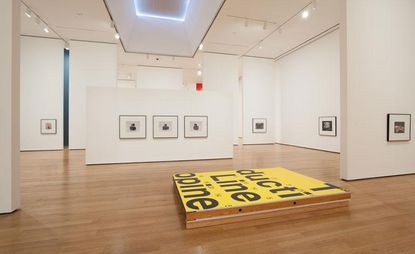
Conceptual artist Christopher Williams’ first retrospective is now on view at the Museum of Modern Art in New York - but don’t tell him that. 'I’m uncomfortable with the term conceptual artist, but I’m equally uncomfortable with the idea that I’m a photographer,' he says. 'Also I was incredibly uncomfortable with the idea of a survey or retrospective.'
Coming from another artist, such statements could be taken as pure contrarianism, deployed to shield, wedge, distance, or simply whine, but for Williams they are a way to reset expectations and invite the viewer into the cross-disciplinary territory he has spent the last 35 years conquering. It is a terrain populated with photographic artifacts (cutaway cameras, Kodak color guides) and glossy ideals (apples, soap, attractive women) that are so slightly and precisely askew, vexing even as they delight. Out of analogue serial production he coaxes endless parallels.
At 58, Los Angeles-born Williams has the easygoing yet brainy charm of a teacher - and he is, at the Kunstakademie Düsseldorf, where he followed Bernd Becher into the role of professor of photography. He compares himself to the magnifying bubble on his iPhone. 'You can move that little bubble around to enlarge images and words, and I think that’s what I do,' he says. 'Instead of being locked behind the camera, I move around. I’m often beside the camera, never in front of the camera, sometimes behind the camera. And I’m as much a photographer as I am a picture editor and a graphic designer.'
The full range of Williams’ practice is represented at MoMA, where 100 photographs - hung low and spaced generously, as if to allow room for their unwieldy titles - are joined by video and film works as well as what the museum describes as 'architectural interventions'. Williams looked to that last category as a way to eschew the inherently backward-looking nature of a retrospective.
The exhibition begins with striking red graphics taken from the show’s previous incarnation at the Art Institute of Chicago. It follows with wall fragments from previous MoMA exhibitions (including the recent Magritte blockbuster, entitled 'The Mystery of the Ordinary'), and finishes by looking forward, via a cinderblock wall, to the retrospective’s spring 2015 outing at Whitechapel Gallery.
'This is an exhibition that redefines the idea of montage, both montage in space - as here photography has been expanded into architecture and as a form of installation art - but also a montage of so many ideas within a single picture frame,' says MoMA curator Roxana Marcoci, who describes Williams as 'a cinephilic artist with a Brechtian flair for quotation'.
For all of the layered complexity and bold non sequiturs of Williams’ work, there is plenty of pure enjoyment to be had in 'The Production Line of Happiness' (a title borrowed from a Jean-Luc Godard documentary) and in the accompanying catalogue-cum-artist’s book. A few steps away from the photo of a 1964 Renault balanced on its side there is a close-up of a pair of beetles (the insects, not the cars) flipped on their backs in surrender.
And when it comes to portraits, the human subjects are distinctively joyful. 'If you look at the work of many of my colleagues, nobody’s smiling. Photography and conceptual art is a very serious business,' says Williams. 'So I thought, I have to find a space to have a position - smiling is maybe the area I can work in.'
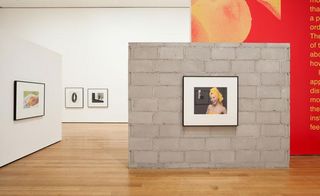
The exhibition, titled 'The Production Line of Happiness', is peppered with bold graphics taken from the show’s previous incarnation at the Art Institute of Chicago, as well as what the museum describes as 'architectural interventions'
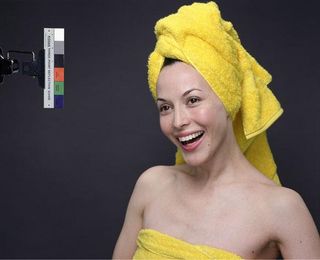
Williams' work is populated with photographic artifacts (cutaway cameras, Kodak color guides) and glossy ideals (apples, soap, attractive women), such as in 'Kodak Three Point Reflection Guide / © 1968, Eastman Kodak Company, 1968 / (Meiko laughing) / Vancouver, B.C. / April 6, 2005', 2005.
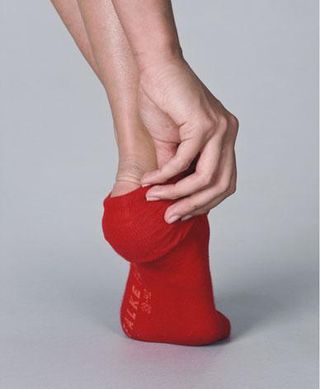
'Untitled (Study in Red) / Dirk Schaper Studio, Berlin / April 30, 2009', 2009. Collection of Constance R Caplan
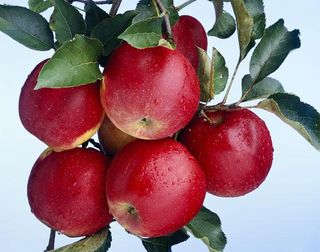
'Bergische Bauernscheune, Junkersholz / Leichlingen, September 29th, 2009', 2010.
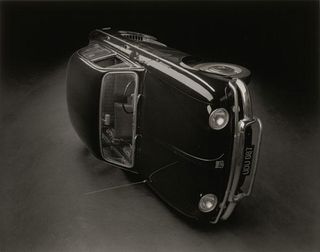
Williams' work coaxes endless parallels out of analogue serial production. A few steps away from this photo of a 1964 Renault balanced on its side there is a close-up of a pair of beetles (the insects, not the cars) flipped on their backs in surrender.
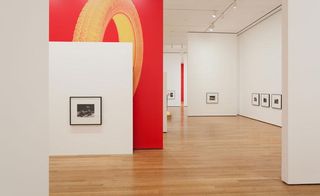
MoMA curator Roxana Marcoci says, 'This is an exhibition that redefines the idea of montage, both montage in space - as here photography has been expanded into architecture and as a form of installation art - but also a montage of so many ideas within a single picture frame'
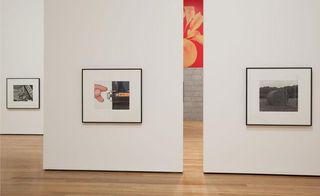
For all of the layered complexity and bold non sequiturs of Williams’ work, there is plenty of pure enjoyment to be had in the show, which borrows its title from a Jean-Luc Godard documentary
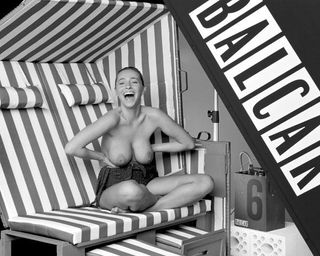
'TecTake Luxus Strandkorb grau/weiß / Model no.: 400636 / Material: wood/plastic / Dimensions (height/width/depth): 154 cm × 116 cm × 77 cm / Weight: 49 kg / Manufactured by Ningbo Jin Mao Import & Export Co., Ltd, / Ningbo, Zhejiang, China for TecTake GmbH, Igersheim, Germany / Model: Zimra Geurts, Playboy Netherlands Playmate of the Year 2012 / Studio Rhein Verlag, Düsseldorf / February 1, 2013 / (Zimra stretching).',
2013
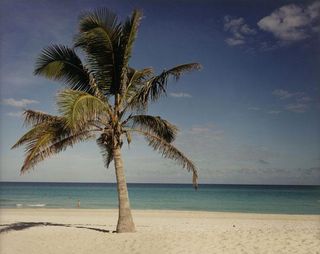
'Punta Hicacos, Varadero, Cuba / February 14, 2000', 2000

'Erratum / AGFA Color (oversaturated) / Camera: Robertson Process Model 31 580 Serial #F97-116 / Lens: Apo Nikkor 455 mm stopped down to f90 / Lighting: 16,000 Watts Tungsten 3200 degrees Kelvin / Film: Kodak Plus-X Pan ASA 125 / Kodak Pan Masking for contrast and colour correction / Film developer: Kodak HC-110 Dilution B (1:7) used @ 68 degrees Fahrenheit / Exposure and development times (in minutes): / Exposure Development / Red Filter Kodak Wratten PM25 2´30˝ 4´40˝ / Green Filter Kodak Wratten PM61 10´20˝ 3´30˝ / Blue Filter Kodak Wratten PM47B 7´00˝ 7´00˝ / Paper: Fujicolor Crystal Archive Type C Glossy / Chemistry: Kodak RA-4 / Processor: Tray', 2005
ADDRESS
MoMA
11 West 53 Street
New York
Wallpaper* Newsletter
Receive our daily digest of inspiration, escapism and design stories from around the world direct to your inbox.
Stephanie Murg is a writer and editor based in New York who has contributed to Wallpaper* since 2011. She is the co-author of Pradasphere (Abrams Books), and her writing about art, architecture, and other forms of material culture has also appeared in publications such as Flash Art, ARTnews, Vogue Italia, Smithsonian, Metropolis, and The Architect’s Newspaper. A graduate of Harvard, Stephanie has lectured on the history of art and design at institutions including New York’s School of Visual Arts and the Institute of Contemporary Art in Boston.
-
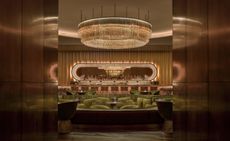 Six brilliant bars for your 2025 celebrations, hot off the Wallpaper* travel desk
Six brilliant bars for your 2025 celebrations, hot off the Wallpaper* travel deskWallpaper’s most-read bar reviews of the year can't be wrong: here’s inspiration for your festive and new year plans, from a swanky Las Vegas lounge to a minimalist London drinking den
By Sofia de la Cruz Published
-
 Misfires and Monstrosities: three vehicular design disasters that show taste is in retreat
Misfires and Monstrosities: three vehicular design disasters that show taste is in retreatFrom a multi-million dollar piece merchandise to a wretched Rolls-Royce, these are the low points of the year in transportation design
By Jonathan Bell Published
-
 Thirty years after Dog Man Star, Brett Anderson looks back on Suede's album covers
Thirty years after Dog Man Star, Brett Anderson looks back on Suede's album coversBrett Anderson talks cover art, photography and iconic imagery
By Amah-Rose Abrams Published
-
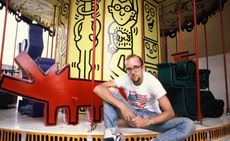 Inside Luna Luna: the amusement park designed by artists lands in New York
Inside Luna Luna: the amusement park designed by artists lands in New York‘Luna Luna: Forgotten Fantasy’ – featuring rides by Basquiat, Lichtenstein, Hockney, Haring, and Dalí – has opened at The Shed
By Osman Can Yerebakan Published
-
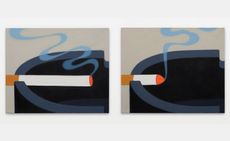 Henni Alftan’s paintings frame everyday moments in cinematic renditions
Henni Alftan’s paintings frame everyday moments in cinematic renditionsConcurrent exhibitions in New York and Shanghai celebrate the mesmerising mystery in Henni Alftan’s paintings
By Osman Can Yerebakan Published
-
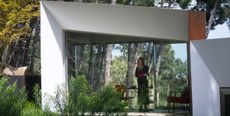 Brutalism in film: the beautiful house that forms the backdrop to The Room Next Door
Brutalism in film: the beautiful house that forms the backdrop to The Room Next DoorThe Room Next Door's production designer discusses mood-boarding and scene-setting for a moving film about friendship, fragility and the final curtain
By Anne Soward Published
-
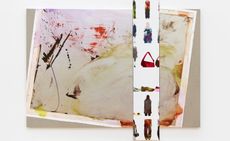 'There’s an anxiety under all of it': Violet Dennison in New York
'There’s an anxiety under all of it': Violet Dennison in New YorkViolet Dennison debuts abstract paintings with new show 'Damaged Self' at Tara Downs Gallery
By Mary Cleary Published
-
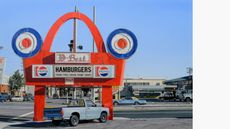 ‘Gas Tank City’, a new monograph by Andrew Holmes, is a photorealist eye on the American West
‘Gas Tank City’, a new monograph by Andrew Holmes, is a photorealist eye on the American West‘Gas Tank City’ chronicles the artist’s journey across truck-stop America, creating meticulous drawings of fleeting moments
By Jonathan Bell Published
-
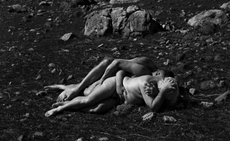 Mark Armijo McKnight’s bodily landscapes capture the tactile serenity of the American West
Mark Armijo McKnight’s bodily landscapes capture the tactile serenity of the American WestThe artist’s new exhibition at the Whitney Museum, which is organised by the museum curator Drew Sawyer, offers a succinct window into his contemplative suggestion of queering a landscape
By Osman Can Yerebakan Published
-
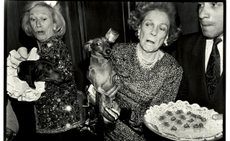 Dark, glamorous and hedonistic: a photography book captures New York in the 1990s
Dark, glamorous and hedonistic: a photography book captures New York in the 1990sNew York: High Life, Low Life, by Dafydd Jones, goes behind the scenes of New York society
By Hannah Silver Published
-
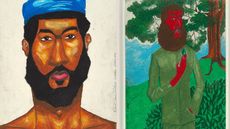 Derrick Alexis Coard’s portraits are a sensitive, positive testimony to Black men
Derrick Alexis Coard’s portraits are a sensitive, positive testimony to Black menThe late artist Derrick Alexis Coard’s retrospective ‘I Am That I Am’, at New York’s Salon 94, honours his ‘symbolic expression for possible change for the African-American male community’
By Tianna Williams Published